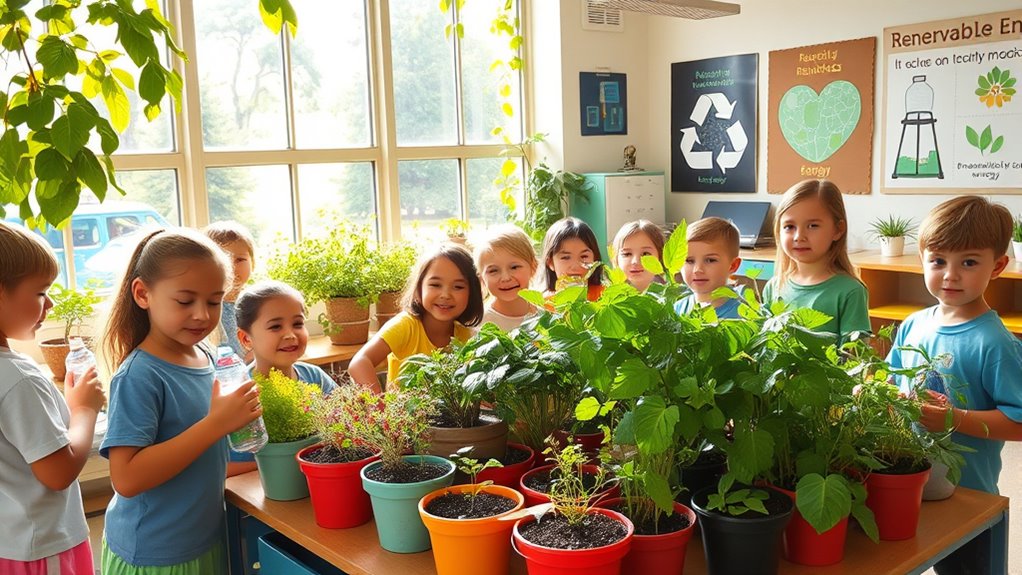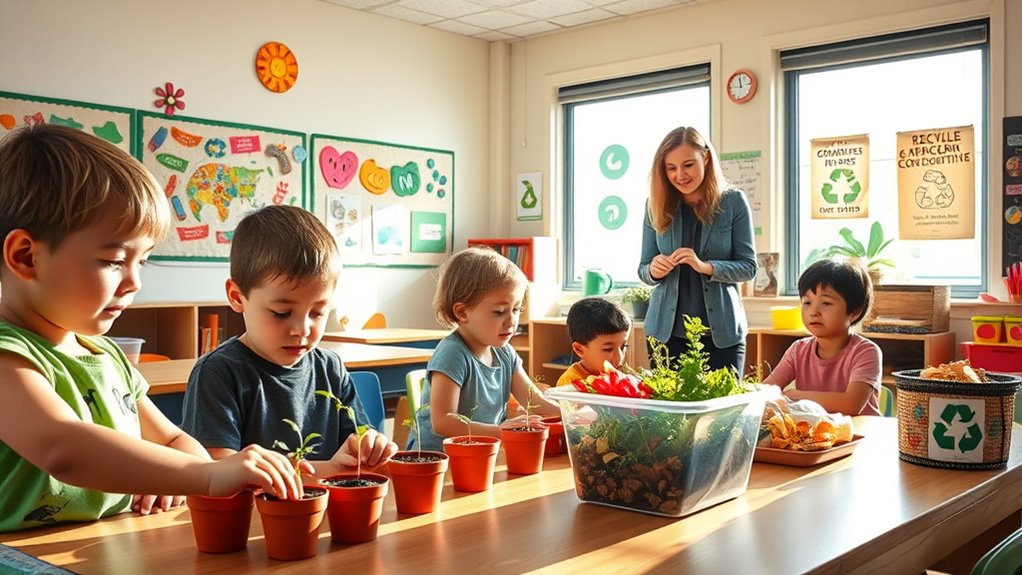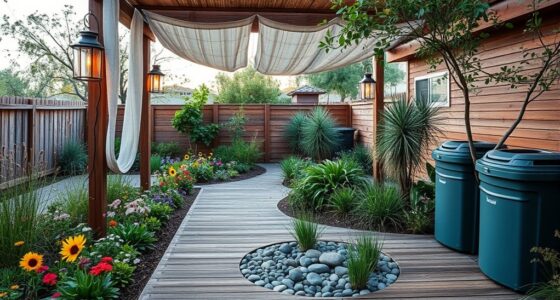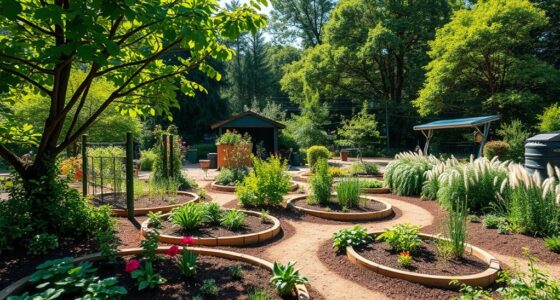To teach kids about sustainability, incorporate fun projects like recycling crafts—making jewelry or planters from recyclable materials—and outdoor adventures such as nature walks to observe ecosystems. Engage their curiosity with hands-on activities that demonstrate environmental impacts, fostering empathy and responsibility. Combining these playful lessons with practical actions helps children see how small steps matter. Keep exploring different activities, and you’ll discover more ways to inspire their lifelong commitment to caring for the planet.
Key Takeaways
- Incorporate recycling crafts like bottle cap jewelry and homemade planters to teach waste reduction creatively.
- Organize outdoor activities such as nature walks to connect children with local ecosystems and environmental awareness.
- Combine hands-on projects with outdoor exploration to reinforce sustainability concepts through practical experience.
- Use engaging, age-appropriate lessons that highlight how small actions contribute to environmental conservation.
- Foster family participation in eco-friendly activities to build lasting sustainable habits and shared environmental responsibility.

Have you ever wondered how to instill a sense of responsibility for the environment in your children? One effective way is to introduce them to eco-friendly activities that make learning about sustainability enjoyable. Recycling crafts are a fantastic starting point. Gather clean recyclable materials like cardboard, plastic bottles, jars, and scrap paper. Show your kids how to turn these items into creative projects—think homemade planters from plastic bottles, picture frames from cardboard, or jewelry from bottle caps. As they craft, explain how recycling reduces waste and conserves resources. This hands-on activity not only sparks their creativity but also helps them see how small actions can make a big difference. Reinforcing the importance of recycling through fun projects makes the concept stick better than just telling them to do so.
In addition to recycling crafts, outdoor adventures serve as a powerful way to teach kids about sustainability. Take them on nature walks, hikes, or visits to local parks and forests. Use these outings as opportunities to explore the environment firsthand. Point out different plants, animals, and natural features, emphasizing their roles in the ecosystem. Discuss how humans can impact these environments positively or negatively. For example, pick up litter you find along the trail, showing them that everyone can contribute to keeping nature clean. Encourage them to observe how different habitats thrive and ask questions about how they can help preserve these natural spaces. Outdoor adventures make ecology real and tangible, fostering a sense of stewardship and respect for the planet. When kids see the beauty of nature up close, they’re more likely to want to protect it.
Both activities—recycling crafts and outdoor adventures—work together to build a practical understanding of sustainability. They help children connect theory to action, showing that caring for the environment isn’t just about big policies but also about everyday choices. By engaging in creative projects, your kids learn that sustainability can be fun and rewarding. Meanwhile, outdoor explorations cultivate curiosity and empathy for the natural world. For example, understanding the importance of pinball machine angles can be related to how small adjustments can improve gameplay and prolong the life of the machine, illustrating the value of precision and care. Keep these activities consistent and age-appropriate, encouraging questions and discussions along the way. When you make sustainability a regular part of your family life, you’re not just teaching your kids about environmental issues—you’re inspiring them to become active, responsible stewards of the planet.
Frequently Asked Questions
How Can I Make Sustainability Lessons Age-Appropriate?
To make sustainability lessons age-appropriate, tailor activities like recycling art and gardening to your kids’ developmental level. For younger children, use simple language and hands-on projects, such as creating art from recycled materials or planting easy-to-grow seeds. For older kids, introduce more complex concepts like composting or energy conservation. Engaging them through fun, relevant activities helps foster a genuine understanding and love for sustainability.
What Are Simple At-Home Projects for Kids?
Like Da Vinci’s inventive spirit, you can spark your kids’ creativity with simple at-home projects. Try recycling crafts by turning old containers into planters or art pieces, making it fun to reuse materials. Play planting games, where children help sow seeds and care for plants, teaching responsibility. These activities involve hands-on learning, promote sustainability, and are easy to do with everyday household items, fostering a love for the environment.
How Can I Involve Children in Community Sustainability Efforts?
You can involve children in community sustainability efforts by encouraging them to participate in neighborhood cleanups and community gardening projects. Explain the importance of taking care of your environment and make it fun by turning cleanup days into games or planting days into mini adventures. Your enthusiasm will inspire kids to get involved, helping them understand sustainability firsthand while making a positive impact on your local community.
What Resources Are Best for Teaching Sustainability?
You should use engaging resources like recycling crafts and eco-friendly games to teach sustainability. These hands-on activities make learning fun and memorable, helping kids understand the importance of caring for the environment. Look for guides and videos online that provide step-by-step instructions for creative projects. Incorporate stories and real-world examples to deepen their understanding. These resources make sustainability concepts accessible and exciting for children.
How Do I Measure Kids’ Understanding of Sustainability Concepts?
Measuring kids’ understanding of sustainability concepts is like catching butterflies—you need the right tools. Use assessment strategies like quizzes, discussions, and project evaluations to gauge comprehension indicators such as application, reasoning, and enthusiasm. Observe how they connect ideas and make eco-friendly choices. These methods help you see if they grasp the concepts, ensuring you’re effectively nurturing their sustainability awareness and guiding them toward responsible habits.
Conclusion
As you guide your kids through these fun projects and lessons, you’re planting seeds of awareness that grow into a greener future. Imagine them exploring a garden, hands in the soil, discovering how small actions can make a big difference. With each activity, you’re helping them see the vibrant world around them—bright, lively, and full of possibilities. Together, you’re nurturing curious minds ready to care for our planet for generations to come.









